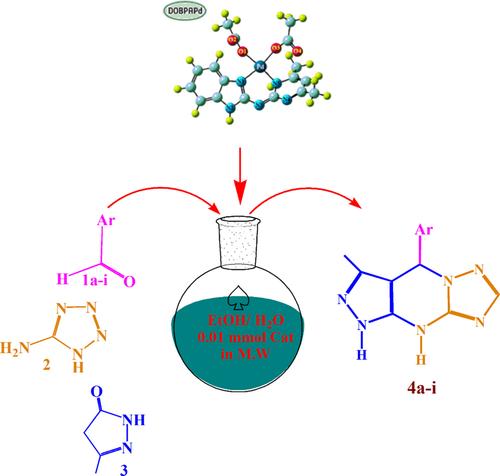当前位置:
X-MOL 学术
›
Appl. Organomet. Chem.
›
论文详情
Our official English website, www.x-mol.net, welcomes your feedback! (Note: you will need to create a separate account there.)
Insights into microwave-promoted synthesis of 3-methyl-4-phenyl-4,9-dihydro-1H-pyrazolo[3,4-d][1,2,4]triazolo[1,5-a]pyrimidine derivatives catalyzed using new Pd (II),Cu (II),VO (II), and Ag(I) complexes as a heterogeneous catalyst and computational studies
Applied Organometallic Chemistry ( IF 3.7 ) Pub Date : 2024-06-18 , DOI: 10.1002/aoc.7587 Mahmoud Abd El Aleem Ali Ali El‐Remaily 1 , Mohammad Saleh Hussein Alzubi 2 , Tarek El‐Dabea 1, 3 , Rafat M. El‐Khatib 1 , Moumen S. Kamel 1 , Mehran Feizi‐Dehnayebi 4 , Ahmed M. Abu‐Dief 1, 5
Applied Organometallic Chemistry ( IF 3.7 ) Pub Date : 2024-06-18 , DOI: 10.1002/aoc.7587 Mahmoud Abd El Aleem Ali Ali El‐Remaily 1 , Mohammad Saleh Hussein Alzubi 2 , Tarek El‐Dabea 1, 3 , Rafat M. El‐Khatib 1 , Moumen S. Kamel 1 , Mehran Feizi‐Dehnayebi 4 , Ahmed M. Abu‐Dief 1, 5
Affiliation

|
Four novel Pd (II), Cu (II), VO (II), and Ag(I) complexes were prepared from benzimidazole ligand through bidentate chelating mode. Alternative spectral and analytical tools were applied to elucidate their structural and molecular formulae. This study was extended to investigate stability and stoichiometry of complexes in solution, using standard methods. In addition, the best atomic distribution within structural forms was obtained via the density functional theory (DFT) method. This computational study fed us with significant physical characteristics for differentiation. Also, DFT/time-dependent DFT computations were performed applying (B3LYP/6-311++G[d,p]/aug-cc-pVTZ/aug-cc-pVTZ-PP) level in order to investigate the electronic behavior of the compounds. These results demonstrated good agreement with the experimental data. Computational data discriminate Pd (II) complex by some physical features, which may be promising in the catalytic field. This complex was selected to play a catalytic function to synthesize 3-methyl-4-phenyl-4,9-dihydro-1H-pyrazolo[3,4-d][1,2,4]triazolo[1,5-a]pyrimidine derivatives using microwave irradiation in a one-pot reaction. The catalyst was selected for this application based on the history of Pd (II) complexes and the properties expected theoretically. A condensation reaction for 3-methyl-5-pyrazolone, aromatic aldehyde, and 5-aminotetrazole was carried out under mild reaction conditions by microwave irradiation. All reaction conditions were optimized among those variable Lewis acid catalysts in comparison with our new complexes. DOBPAPd catalyst displayed superiority in overall trials with high yield, short time, and green conditions (solvent H2O/EtOH). Also, the recovery of hetero catalyst was succeeded and reused by the same efficiency up to five times after that the efficiency was reduced. The mechanism of action was proposed based on the ability of Pd (II) for adding extra-bonds over z-axis and supported by theoretical aspects.
中文翻译:

微波促进催化合成 3-甲基-4-苯基-4,9-二氢-1H-吡唑并[3,4-d][1,2,4]三唑并[1,5-a]嘧啶衍生物的见解新的 Pd (II)、Cu (II)、VO (II) 和 Ag(I) 配合物作为多相催化剂和计算研究
以苯并咪唑配体为原料,通过双齿螯合模式制备了四种新型的Pd(II)、Cu(II)、VO(II)和Ag(I)配合物。应用替代光谱和分析工具来阐明它们的结构和分子式。这项研究扩展到使用标准方法研究溶液中复合物的稳定性和化学计量。此外,通过密度泛函理论(DFT)方法获得了结构形式内的最佳原子分布。这项计算研究为我们提供了用于区分的重要物理特征。此外,应用 (B3LYP/6-311++G[d,p]/aug-cc-pVTZ/aug-cc-pVTZ-PP) 水平进行 DFT/时间相关 DFT 计算,以研究化合物。这些结果与实验数据吻合良好。计算数据通过一些物理特征来区分 Pd (II) 配合物,这在催化领域可能很有前景。该配合物对合成3-甲基-4-苯基-4,9-二氢-1H-吡唑并[3,4-d][1,2,4]三唑并[1,5-a]具有催化作用。使用微波辐射进行一锅反应的嘧啶衍生物。根据 Pd (II) 配合物的历史和理论上预期的性能,为本应用选择了催化剂。在温和的反应条件下,通过微波辐射进行3-甲基-5-吡唑啉酮、芳香醛和5-氨基四唑的缩合反应。与我们的新配合物相比,所有反应条件都在这些可变路易斯酸催化剂中进行了优化。 DOBPAPd催化剂在整体试验中表现出产率高、时间短、条件绿色(溶剂H 2 O/EtOH)的优越性。 此外,杂催化剂的回收成功,并在效率降低后以相同的效率重复使用达五次。该作用机制是基于 Pd (II) 在 z 轴上添加额外键的能力提出的,并得到了理论方面的支持。
更新日期:2024-06-18
中文翻译:

微波促进催化合成 3-甲基-4-苯基-4,9-二氢-1H-吡唑并[3,4-d][1,2,4]三唑并[1,5-a]嘧啶衍生物的见解新的 Pd (II)、Cu (II)、VO (II) 和 Ag(I) 配合物作为多相催化剂和计算研究
以苯并咪唑配体为原料,通过双齿螯合模式制备了四种新型的Pd(II)、Cu(II)、VO(II)和Ag(I)配合物。应用替代光谱和分析工具来阐明它们的结构和分子式。这项研究扩展到使用标准方法研究溶液中复合物的稳定性和化学计量。此外,通过密度泛函理论(DFT)方法获得了结构形式内的最佳原子分布。这项计算研究为我们提供了用于区分的重要物理特征。此外,应用 (B3LYP/6-311++G[d,p]/aug-cc-pVTZ/aug-cc-pVTZ-PP) 水平进行 DFT/时间相关 DFT 计算,以研究化合物。这些结果与实验数据吻合良好。计算数据通过一些物理特征来区分 Pd (II) 配合物,这在催化领域可能很有前景。该配合物对合成3-甲基-4-苯基-4,9-二氢-1H-吡唑并[3,4-d][1,2,4]三唑并[1,5-a]具有催化作用。使用微波辐射进行一锅反应的嘧啶衍生物。根据 Pd (II) 配合物的历史和理论上预期的性能,为本应用选择了催化剂。在温和的反应条件下,通过微波辐射进行3-甲基-5-吡唑啉酮、芳香醛和5-氨基四唑的缩合反应。与我们的新配合物相比,所有反应条件都在这些可变路易斯酸催化剂中进行了优化。 DOBPAPd催化剂在整体试验中表现出产率高、时间短、条件绿色(溶剂H 2 O/EtOH)的优越性。 此外,杂催化剂的回收成功,并在效率降低后以相同的效率重复使用达五次。该作用机制是基于 Pd (II) 在 z 轴上添加额外键的能力提出的,并得到了理论方面的支持。












































 京公网安备 11010802027423号
京公网安备 11010802027423号